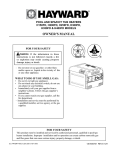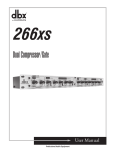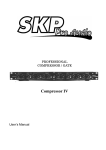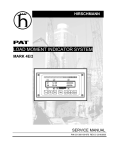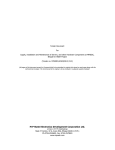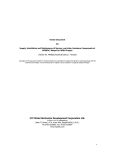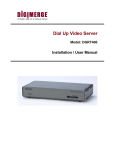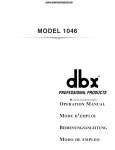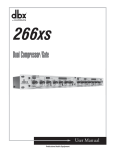Download dbx 290 Specifications
Transcript
MODEL 1046 Operation Manual Contents Introduction................................................................................. 2 Inspection..................................................................................... 2 Warranty...................................................................................... 2 Connecting the 1046 to your system........................................... 3 Operating Controls....................................................................... 3 Rear Panel Operations.................................................................. 6 Applications.................................................................................. 7 Installation Considerations........................................................... 8 Specifications................................................................................ 9 Manual Contents 1 Introduction Congratulations and thank you for your purchase of the dbx 1046 Quad Compressor Limiter. The dbx 1046 is a high performance multifunctional unit designed to deliver all the flexibility and power that a professional user demands. The dbx 1046 incorporates the new advanced dbx V2™ VCA for high system performance. We recommend you take a moment to read through this Operation manual. It provides information that will assist you in system set-up. Inspection Verify that the 1046’s package contains the following: • • • • • 1046 Unit (according to Model number marked on package) AC Power Cord Operation Manual Registration Card 4 Rack Mount Screws and Washers If any of these items are missing, contact dbx customer service at (801) 568-7660. Warranty 1. T he warranty registration card that accompanies this product must be mailed within 30 days after purchase date to validate this warranty. Proof-of-purchase is considered to be the burden of the consumer. 2. dbx warrants this product, when bought and used solely within the U.S., to be free from defects in materials and workmanship under normal use and service. 3. d bx liability under this warranty is limited to repairing or, at our discretion, replacing defective materials that show evidence of defect, provided the product is returned to dbx WITH RETURN AUTHORIZATION from the factory, where all parts and labor will be covered up to a period of two years. A Return Authorization number must be obtained from dbx by telephone. The company shall not be liable for any consequential damage as a result of the product’s use in any circuit or assembly. 4. d bx reserves the right to make changes in design or make additions to or improvements upon this product without incurring any obligation to install the same additions or improvements on products previously manufactured. 5. The foregoing is in lieu of all other warranties, expressed or implied, and dbx neither assumes nor authorizes any person to assume on its behalf any obligation or liability in connection with the sale of this product. In no event shall dbx or its dealers be liable for special or consequential damages or from any delay in the performance of this warranty due to causes beyond their control. 2 Introduction Connecting the 1046 to your system To connect the 1046 to your system, refer to the following steps: • Turn off all equipment before making any connections. • Mount the 1046 in a rack I nstall the 1046 in a rack with the rack screws provided. It can be mounted above or below anything that does not generate excessive heat. Ambient temperatures should not exceed 113˚ F (45˚ C) when equipment is in use. Although the unit is shielded against radio frequency and electromagnetic interference, extremely high fields of RF and EMI should be avoided. • Make audio connections via XLR, 1/4” TRS, or 1/4” TS plugs. B oth types of connectors for the inputs and outputs can be used for balanced or unbalanced connections. The use of more than one connector at a time for the input/output pair could unbalance balanced lines, cause phase cancellations, short a conductor to ground, or cause damage to other equipment connected to the 1046. • Apply power to the 1046 Connect the AC power cord to the AC power receptacle on the back of the unit. Route the AC power cord to a convenient power outlet away from audio lines. The unit may be turned on and off via the rear panel power switch or from a master equipment power switch. Operating Controls Front Panel GAIN REDUCTION dB 30 -20 25 -10 20 15 10 6 INPUT / OUTPUT LEVEL dBu 3 CHANNEL ONE 0 -30 2:1 1 -24 3:1 -6 0 +6 -10 +10 I/O Meter 1:1 RATIO +12 GAIN REDUCTION dB THRESHOLD + +18 0 8:1 OverEasy -40 dBu +20 THRESHOLD -12 4:1 +10 1.5:1 PROFESSIONAL PRODUCTS -18 +12 +10 30 +14 +6 COMPRESSOR -10 20 15 +4 dBu OFF PeakStopPlus LIMITER 10 6 INP 3 CHANNEL TWO 0 +20 -30 Stereo Couple Bypass -20 dB +20 OUTPUT GAIN :1 -20 25 2:1 1 3:1 8:1 OverEasy -40 dBu +20 THRESHOLD RATIO POWER: 25 WATTS OUTPUTS :1 COMPRESSOR Compressor Threshold Control - This control sets the level above which compression occurs, and has a 60 dB range. CHANNEL FOUR FUSE: REPLACE WITH SAME OPERATING -1 I/O Meter 1:1 +4 dBu Connecting the 1046 to LEVEL your system-10 dBV -18 4:1 +10 1.5:1 Gain Reduction Meter - This 8 stage meter shows the amount of gain reduction due to both compression and/ or Intelligent Predictive Limiting™, displaying gain reduction from 0 to 30 dB. TYPE FUSE AND RATING. 200-240V ATTENTION: UTILISER UN 50/60Hz FUSIBLE DE RECHANGE DE MEME TYPE ET CALIBRE. 100-120V: 250mA 250V SLOW BLOW 200-240V: T 125mA L 250V 100-120V MADE IN USA 50/60Hz MODEL 1046 -24 INPUTS 3 1:1 OUTPUT LEVEL (dB) +20 +15 2:1 +10 4:1 +5 0 AM −5 R BE :1 RED Above Threshold OverEasy Range G RE EN OverEasy® Switch - OverEasy® provides a smooth transition from the compressor’s linear region to the −15 Threshold compressed region. ThisBelow smooth transition greatly reduces compression artifacts and allows higher compression ratios while still −15 maintaining characteristics of the signal. The switch lights to indicate OverEasy® −10 −5 +15 +20 +10 natural 0 +5the LEVEL (dB) processing is enabled. INPUT When conventional hard knee processing is desired, disable the OverEasy® function. See Figure 1 below. −10 1:1 Unity 1:1 +20 +15 2:1 +10 4:1 +5 20:1 0 :1 -5 Rotation Point Threshold -10 +15 2:1 +10 4:1 +5 0 −5 A -15 -10 -5 0 G GREEN Below Threshold −15 +5 +10 +15 +20 R RED :1 Above Threshold OverEasy Range RE −10 -15 E MB EN RED Above Threshold OUTPUT LEVEL (dB) OUTPUT LEVEL (dB) +20 Below Threshold −15 −10 −5 0 +5 +10 +15 +20 INPUT LEVEL (dB) INPUT LEVEL (dB) Figure 1: Hard Knee Compression Curve and OverEasy® Compression Curve. 1:1 Unity +20 RED Above Threshold OUTPUT LEVEL (dB) +15 Compressor Ratio Control - This control selects the ratio between input and the output levels for signals 2:1 above the level set by the COMPRESSION THRESHOLD control.+10It is adjustable between4:11:1 and ∞:1. Note, when +5 OverEasy® processing is selected, the ratio transitions smoothly from the linear to the20:1compressed region. As 0 the signal exceeds the threshold, the ratio approaches the ratio set by the COMPRESSOR:1 RATIO control. -5 Rotation Point Threshold Figure 2 shows the effect of 2:1 compression on a signal as -10 it rises above and falls below the threshold. Below GREEN Below Threshold -15 the output the threshold the signal is not affected. Above the threshold, signal increases by only half of the increase (in dB) of the input signal level. In other words, with a 2 dB increase in input level, the output -15 -10 -5 0 +5 +10 +15 +20 increases by only 1 dB, hence the 2:1 compression ratio. INPUT LEVEL (dB) Signal Level (dBu) Signal Level (dBu) 10 0 10 Input Signal 0 Above Threshold -10 -20 Input Signal Above Threshold -10 -20 -30 Below Threshold Time -40 -30 -40 Output Signal Below Threshold Time Figure 2: Compression Effect on Signal Level with a 2:1 Ratio at a -20 dBu Threshold Input/Output Level Meter - This 8-stage meter directly reads the input and output levels when the rear-panel OPERATING LEVEL SWITCH is in the +4 dBu position. In the -10 dBV position, the input signal is boosted by 11.8 dB (the difference between +4 dBu and -10 dBV) to convert a semi-pro -10 dBV level signal to the professional +4 dBu internal level of the 1046, while the output signal is attenuated by 11.8 dB to convert back to a -10 dBV level. Since the meter is calibrated for +4 dBu operation, it reads about 12 dB higher than the actual input and output signal levels when the OPERATING LEVEL SWITCH is set to -10 dBV. 4 Operating controls Input/Output Meter Switch - This switch selects the signal for metering by the INPUT/OUTPUT LEVEL METER. The switch lights indicating the input signal is currently being sent to the meter. When the switch is in the out position, the output signal is selected for metering, and the switch will not be illuminated. Output Gain Control - This control sets the output gain of the compressor. It can be continuously adjusted between -20 dB and +20 dB. Use this control to compensate for signal level loss due to compression and to adjust the nominal output level of the unit. Bypass Switch - This switch bypasses the unit completely, “hard-wiring” the input directly to the output, and the signal is not processed in any way. The switch will light indicating that the unit is currently bypassed. PeakStopPlus™ Level Control - This control sets the level to which the output signal is reduced whenever it exceeds this level. It can be adjusted between +4 dBu and +22 dBu (OFF). This PeakStopPlus™ limiter uses a propietary dbx two-stage limiting process. The first stage is the Instantaneous Transient Clamp™ which clamps the signal with a soft logarithmic clamp function. This logarithmic function assures that the signal will not exceed the level set by the PeakStopPlus™ LEVEL control by more than 2 dB typically, and that it will not introduce harsh artifacts. The second stage is a unique program limiter featuring Intelligent Predictive Limiting™. Its function is to monitor the input signal and intelligently predict the amount of gain reduction needed to keep the output signal below the ceiling set by the Instantaneous Transient Clamp™. The PeakStopPlus™ limiter must come after the OUTPUT GAIN control. If the OUTPUT GAIN is set too high as compared to the PeakStopPlus™ LEVEL control, continuous limiting can occur. While PeakStopPlus™ is typically used as a protective function, creative effects can be achieved by intentionally driving the signal into heavy PeakStopPlus™ limiting. Great care has gone into the design of the PeakStopPlus™ limiter to keep it acoustically transparent. Appropriate use of it can protect your gear while keeping the signal free of artifacts. PeakStopPlus™ Threshold (+) LED Indicator - This LED illuminates when the output signal exceeds the level set by the PeakStopPlus™ LEVEL control indicating that PeakStopPlus™ limiting is occurring. Figure 3 illustrates the protective action of the PeakStopPlus™ limiter. The signal with the thin line weight represents an unaltered input signal. As you can see, peaks of the input signal exceed the clamping level. The signal with the heavier line weight represents the output signal. The peaks of the input signal which exceeded the clamping level are not allowed to exceed this level at the output. This instantaneous protective action is invaluable for driver protection in speaker systems and for digital recording where it is desirable to record as “hot” as possible, while still avoiding the disastrous result of running out of headroom. Following this clamping action, Intelligent Predictive Limiting™ takes over, typically within 5ms, as long as the input signal continues to exceed the PeakStopPlus™ threshold. This program limiter quickly attenuates the input signal to a level safely below the clamping level, typically 2 dB lower than the clamping level. The PeakStopPlus™ level control is calibrated to this lower level, so if an absolute ceiling is required, set the level 2 to 3 dB below the front panel setting. The attack and release times of the Instantaneous Transient Clamp™ are zero, while the Intelligent Predictive Limiting™ attack and release times are program-dependent. That is, for larger excursions over the threshold, the attack time speeds up, and for smaller excursions over the threshold, the attack time slows down. Similarly, for large excursions over the threshold which cause more PeakStopPlus™ gain reduction, the release time increases and is roughly proportional to the amount of gain reduction that occurred. Operating Controls 5 Output Signal } Input Signal Intelligent Predictive Limiting™ Attack Time 2 dB Typically Release Time Output Signal Time Figure 3: Protective Action of the PeakStopPlus™ Limiter Stereo Couple Switch - These switches change the 1046 from four independent compressors into two stereo compressors. In stereo mode, Channel 1 is the master and Channel 2 is its slave, and Channel 3 is the master and channel 4 is its slave. Each of the Channel 2 and 4 controls and switch functions will be overriden and controlled by the Channel 1 and 3 controls and switches, respectively, except for the I/O Meter and Bypass switches. Also, Channel 2’s and 4’s Compressor Threshold, and PeakStopPlus™ Threshold meters will be disabled, while these slave channels’ Gain Reduction meters will indicate the amount of gain reduction occurring, as on their masters’ Gain Reduction Meters. All 4 channels have equal precedence as far as signal processing is concerned. The dbx 1046 uses True RMS Power Summing™, an extremely accurate and musical way to combine detector outputs in a stereo situation. The switch will light to indicate that the 1046 is in the Stereo Couple mode. Rear Panel Operations Rear Panel 30 FUSE: T 300mA L 250V AC Power Receptacle - Use the supplied AC cable to connect the unit to AC power. The AC receptacle includes an integral pull-out fuse drawer which contains two fuses; the active fuse and a spare fuse. Replace the fuse with the same type and rating only.as indicated on the rear panel. Audio Inputs - Each channel features both XLR and 1/4” TRS electronically balanced inputs. Inputs may be used in a balanced or unbalanced configuration. Note that the XLR and 1/4’ inputs may NOT be used simultaneously. 6 Rear panel operations Audio Outputs - Each channel features both XLR and 1/4” TRS servo-balanced outputs. Outputs may be used in a balanced or unbalanced configuration. Unlike the inputs both the XLR and the 1/4” outputs may be used simultaneously. An output transformer option is available when very long cable distances are required (see “Specifications”). Operating Level Switch - This switch selects between a -10 dBV and +4 dBu nominal operating level. When the switch is in the in position, a -10 dBV operating level is selected. When it is in the out position, +4 dBu is selected. This switch affects both the input and the output levels. Applications Fattening Kick Drums and Compressing Other Drums Weak, flabby kick drums often have too much boom, and not enough slap. To tighten them up, start with the 1046 adjusted for a medium to high RATIO (e.g., 6:1), adjust the THRESHOLD control so that the GAIN REDUCTION meters show 15 dB of gain reduction, then increase the RATIO if necessary. In OverEasy® mode, the 1046 takes slightly longer to react than in Hard Knee mode, and will therefore emphasize the slap at the beginning of the note and reduce the boominess of its body. The 1046 also works well for tightening snare drums and tom toms and can be used with drum machines to effectively alter the character of any electronic drum sound. Raising a Signal Out of a Mix Since reducing dynamic range increases the average signal level by a small amount, a single track can be raised out of a mix by boosting its level slightly and applying compression. Start with a 2:1 RATIO and a relatively low THRESHOLD setting (-20 dBu). Adjust both controls as necessary. Compressors have also been used to bring vocals to the forefront of a mix in volume-restricted studios (e.g. home studios). Start by adding a foam windscreen to the mic (if it doesn’t have one). Set the RATIO to 10:1 and the THRESHOLD to -10 dBu. With your mouth approximately 2 inches from the mic, sing the vocal part, but with less volume than normal. Use phrasing to give the part some intensity. An equalizer (e.g., a dbx 242 Parametric Equalizer, dbx 30 Series Graphic Equalizers) or a vocal effects device (e.g., a dbx 290 digital reverb) can be added to further define the performance. Note: When compressing a stereo program with a 1046, the factors affecting a compression curve and the actual RATIO and THRESHOLD settings are the same as those previously covered with reference to single channels of program material. However, it will generally be found that large amounts of compression are more audible in a mixed stereo program than they might be on the separate tracks that were mixed to create the program. Smoothing out Microphone Levels When distance is created between the vocalist and the microphone there will be a variation in the signal level. Start with low compression (around 2:1) to smooth out any variations. Limiting also benefits intelligibility by allowing low-level input signals to be reproduced through the system at higher volume. Smoothing out Musical Instrument Levels Compression smooths out the variations of loudness among instruments. Using the 1046 can also increase the instrument’s sustain. Compress the instrument’s output with a ratio of about 4:1. Speaker Protection Compressors are frequently used to prevent excessive program levels from distorting power amps and/or Applications 7 damaging drivers in a sound-reinforcement system (whether you’re doing auditorium, church, or club sound engineering, or are a mobile DJ, or like to push the limits of your home’s audio entertainment center). Set the 1046 for limiting (Hard Knee mode On, with a RATIO of 10:1 or greater) and adjust the THRESHOLD to provide 15 dB or more of compression (just a few dB below the input clip). For low-level signals, the 1046 won’t change gain, but if large signals come along, the gain will be reduced to prevent clipping and save sensitive system components from excessive heat buildup or other types of damage. Note: PeakStopPlus™ Limiting can also be used to prevent speaker damage. Preventing Digital Recording Overload Some digital recorders and samplers produce audible distortion when they exceed their maximum operating level. The 1046 can be used to ensure that audio input does not overload a digital recorder’s A/D (analog-to-digital) converters. The 1046 can perform this function quietly enough for all digital media. To use the 1046 so that no changes in gain occur unless an emergency arises (wildly excessive levels), set Hard Knee mode On, the RATIO to ∞:1, and the THRESHOLD highest level before digital overload. Note: PeakStopPlus™ limiting can also be used to prevent raucous-sounding digital overload. Installation Considerations Hookups and Cabling: The 1046 is designed for nominal -10 dBV or +4 dBu levels. The 1046 can be used with either balanced or unbalanced sources and the outputs can be used with either balanced or unbalanced loads, provided the proper cabling is used. Normal Balanced Connections for Inputs and Outputs Connection XLR TRS 1/4” Jack Ground: Pin 1 Sleeve High: Pin 2 Tip Low: Pin 3 Ring Normal Unbalanced Connections for Inputs and Outputs Connection XLR TRS 1/4” Jack TS 1/4” Jack Ground: Pin 1 Sleeve Sleeve High: Pin 2 Tip Tip Low (ground): Pin 3 Ring Sleeve Tie pin 3 to the ground for unity gain in/out of the 1046 when using unbalanced input connections to balanced output connections or balanced input connections to unbalanced output connections. To do otherwise won’t hurt the unit but will result in unmatched input to output levels, and the level control will not be properly calibrated. 8 Installation considerations Specifications Input Connectors: Type: Impedance: Max Input Level: CMRR: Output Connectors: Type: Impedance: Max Output Level: Female XLR and 1/4” TRS (Pin 2 and tip hot) Electronically balanced/unbalanced, RF filtered Balanced > 50 kΩ, unbalanced >25 kΩ > +24 dBu balanced or unbalanced 40 dB; Typically >55 dB at 1 kHz Male XLR and 1/4” TRS (Pin 2 and tip hot) Servo-balanced/unbalanced, RF filtered Balanced 60Ω, unbalanced 30Ω > +21 dBu, >+20 dBm balanced/unbalanced System Performance Bandwidth: 20 Hz to 20 kHz, +0/-0.5 dB Frequency Response: 0.35 Hz to 200 kHz, +0/-3 dB Noise:< -94 dBu, unweighted, 22 kHz measurement bandwidth Dynamic Range: > 118 dB, unweighted THD+Noise: 0.009% typical at +4 dBu, 1 kHz unity gain 0.09% typical at +20 dBu, 1 kHz, unity gain < 0.1% any amount of compression up to 40 dB, 1 kHz IMD: < 0.1% SMPTE Interchannel Crosstalk: < -85 dB, 20 Hz to 20 kHz VCA: dbx V2™ Stereo Coupling: True RMS Power Summing Compressor Threshold Range: Ratio: Threshold Characteristic: Attack/Release Characteristic: Attack Time: Release Time: Output Gain: Limiter Threshold Range: Ratio: Limiter Type: Stage 1: Attack Time: Release Time: Stage 2: Attack Time: Release Time: Function Switches OverEasy®: I/O Meter: Bypass: Operating Level (rear panel): Stereo Couple: -40 dBu to +20 dBu 1:1 to ∞:1 Selectable OverEasy® or hard knee AutoDynamic™ Program-dependent, typically 15ms for 10 dB, 5 ms for 20 dB, 3 ms for 30 dB Program-dependent, typically 125 dB/sec -20 to +20 dB +4 dBu to +22 dBu (off) ∞:1 PeakStopPlus™ two-stage limiter Instantaneous Transient Clamp™ Zero Zero Intelligent Predictive Limiting™ Program-dependent, typically <5 msec Program-dependent, typically 22 dB/sec Activates the OverEasy® compression function. Switches between monitoring input and output levels on the Input/Output Level meter. Activates the direct input-to-output hard-wire bypass. Switches the nominal operating level between-10 dBV and +4 dBu simultaneously for both input and output levels. Couples channels in stereo pairs. Channels One and Three become the master channels. Indicators Gain Reduction8 segment LED bar graph at 1, 3, 6, 10, 15, 20, 25, and 30 dB Input/Ouptut Level8-segment LED bar graph at -24, -18, -12, -6, 0, +6, +12, and +18 dBu Limiter Threshold: 1 LED to indicate PeakStopPlus™ limiting Function Switches: LED indicator for each front-panel switch Specifications 9 Power Supply Operating Voltage: Factory selected: 100-120 VAC 50/60 Hz or 200-240 VAC 50/60 Hz Power Consumption: 30 Watts Fuse: 100-120 VAC: T 300 mA L 250V 200-240 VAC: T 160 mA L 250V Mains Connection: IEC receptacle Physical Dimensions: 1.75” H x 19” W x 9” D 44.5 x 483 x 229 mm Weight: 7.4 lbs. 3.4 kg Shipping Weight: 9.8 lbs. 4.4 kg Options Output Transformer Per Channel: Jensen® JT-123-dbx or BCI™ RE-123-dbx Note: Specifications subject to change. 10 Specifications











